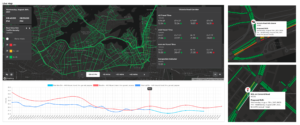If you live in Sydney or travel into the city for work, you’ve likely spent a good part of your life sitting in traffic. Sydney’s transport network spans more than 12,000 square kilometres and carries millions of people a day across different intersecting modes of transport. When an accident, storm or construction enters the mix, the impact can be catastrophic.
The task of managing planned and unplanned events on the network is currently significantly manual, time consuming and reliant on operator's experience. At CSIRO’s Data61, our researchers have harnessed the power of predictive data analytics, simulation and artificial intelligence (AI) to help relieve this burden.
Now, decisions which previously relied on the manual integration of a dozen distinct systems/datasets at Transport for NSW can be made using one intelligent system. The result: a first of its kind system driving Sydney, and Australia, towards a smarter, safer and cleaner commute.

Introducing the Decision Support System
Since June 2020, a Data61 research team have been working with Transport for NSW to transform Sydney’s transport network management and planning processes with cutting-edge data and digital science.
The Decision Support System (DSS) ingests and collates all available data feeds in one cohesive dashboard, providing a clear and accurate picture of the present.
But its real power is in the combination of this data with industry leading simulation technology from Aimsun. The DSS is the first in the world to combine AI-driven predictive analytics with behavioural simulation technology to allow operators to see into the future and test multiple possible responses in parallel.
"We can use DSS simulations to accurately determine an hour in advance how many vehicles are going to be using an intersection, the speed of these vehicles, the patronage of the public transport, and the quantity of surrounding foot traffic. When an event happens, operators will immediately know how it impacts travellers and be able to make more informed and effective mitigation decisions,” project leader Dr. Chen Cai said.
"It's a whole package. It can continuously ingest and synthesise data to enable predictive modelling and simulations. The DSS provides a coherent solution for the day-to-day online management of a transport network," Dr. Cai said.

In transit to a better future
It’s not just commuters’ blood pressure that this data-rich approach has the potential to impact. Improved traffic management using the DSS positively impacts:
The economy
The cost of congestion in the greater Sydney region is projected to rise from $8.1 billion in 2016 to $15.9 billion in 2031. Every hour commuters are stuck in traffic costs the economy $25, a figure that doubles for freight drivers. Improving Journey Time Reliability (how stable the travel time is from A to B) allows business operators to better plan and optimise their logistics.
Safety
More harmonic traffic = less accidents. With millions of travellers using Sydney’s network every day, increasing awareness of events on the network could reduce incidents.
The environment
Stop and start traffic exacerbates emissions. In Australia’s most congested city, improving the network’s operation could reduce air pollution caused by traffic.
The Pilot
The research team are currently testing the DSS Pilot on Victoria Road, connecting the Parramatta and Sydney CBD. As one of city’s most congested corridors and a focus for future development, the corridor is fertile ground for testing the system's potential.
Key to the system’s success is its applicability to a wide range of management stakeholders, from event planning to emergency response to transport mode operators like Sydney Trains.
More than 139 requirements from various stakeholders in the form of acceptance criteria have been met as part of the development process. Three categories of events have been simulated on the system: planned road closures, unplanned traffic incidents and public transport service shutdowns. The product is currently in the final stages of assessment for operationalisation by Transport for NSW.
The Future
The DSS Pilot presents an opportunity to revolutionise transport management and planning beyond Sydney.
“Other jurisdictions, transport agencies, researchers and consultants can use this platform to understand the impact of any major infrastructure work on the traffic network,” Dr. Cai said.
“Our goal is to scale the system so it can be deployed in a number of days, with users utilising the benefits in the first week instead of the first year.
“Major transport infrastructure projects currently require several months of modelling and appraisal prior to the completion of a report, which is time consuming, repetitive and capital intensive.”
“By consolidating existing data feeds into a single source of truth with built-in predictive models, our system is able to realise benefits to clients in days."
For more information about the DSS, contact Dr. Chen Cai at chen.cai@data61.csiro.au.
